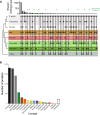Transcriptome, proteome and draft genome of Euglena gracilis
- PMID: 30732613
- PMCID: PMC6366073
- DOI: 10.1186/s12915-019-0626-8
Transcriptome, proteome and draft genome of Euglena gracilis
Abstract
Background: Photosynthetic euglenids are major contributors to fresh water ecosystems. Euglena gracilis in particular has noted metabolic flexibility, reflected by an ability to thrive in a range of harsh environments. E. gracilis has been a popular model organism and of considerable biotechnological interest, but the absence of a gene catalogue has hampered both basic research and translational efforts.
Results: We report a detailed transcriptome and partial genome for E. gracilis Z1. The nuclear genome is estimated to be around 500 Mb in size, and the transcriptome encodes over 36,000 proteins and the genome possesses less than 1% coding sequence. Annotation of coding sequences indicates a highly sophisticated endomembrane system, RNA processing mechanisms and nuclear genome contributions from several photosynthetic lineages. Multiple gene families, including likely signal transduction components, have been massively expanded. Alterations in protein abundance are controlled post-transcriptionally between light and dark conditions, surprisingly similar to trypanosomatids.
Conclusions: Our data provide evidence that a range of photosynthetic eukaryotes contributed to the Euglena nuclear genome, evidence in support of the 'shopping bag' hypothesis for plastid acquisition. We also suggest that euglenids possess unique regulatory mechanisms for achieving extreme adaptability, through mechanisms of paralog expansion and gene acquisition.
Keywords: Cellular evolution; Euglena gracilis; Excavata; Gene architecture; Horizontal gene transfer; Plastid; Secondary endosymbiosis; Splicing; Transcriptome.
Conflict of interest statement
Ethics approval and consent to participate
Not applicable.
Consent for publication
Not applicable.
Competing interests
The authors declare that they have no competing interests.
Publisher’s Note
Springer Nature remains neutral with regard to jurisdictional claims in published maps and institutional affiliations.
Figures






References
-
- Dobell C. Antony van Leeuwenhoek and his “Little Animals.” 1932. doi:10.1038/130679a0.
-
- Kim JT, Boo SM, Zakryś B. Floristic and taxonomic accounts of the genus Euglena (Euglenophyceae) from Korean fresh waters. Algae. 1998;13:173–197.
-
- Gojdics M. The genus Euglena. American Association for the Advancement of Science; 1953. doi:10.1126/science.120.3124.799-a.
-
- Zakryś B, Walne PL. Floristic, taxonomic and phytogeographic studies of green Euglenophyta from the Southeastern United States, with emphasis on new and rare species. Algol Stud für Hydrobiol Suppl Vol. 1994;72:71–114.
-
- Zakryś B. The nuclear DNA level as a potential taxonomic character in Euglena Ehr. (Euglenophyceae). Algol Stud für Hydrobiol Suppl Vol. 1988;:483–504.
Publication types
MeSH terms
Substances
Grants and funding
LinkOut - more resources
Full Text Sources
Miscellaneous

